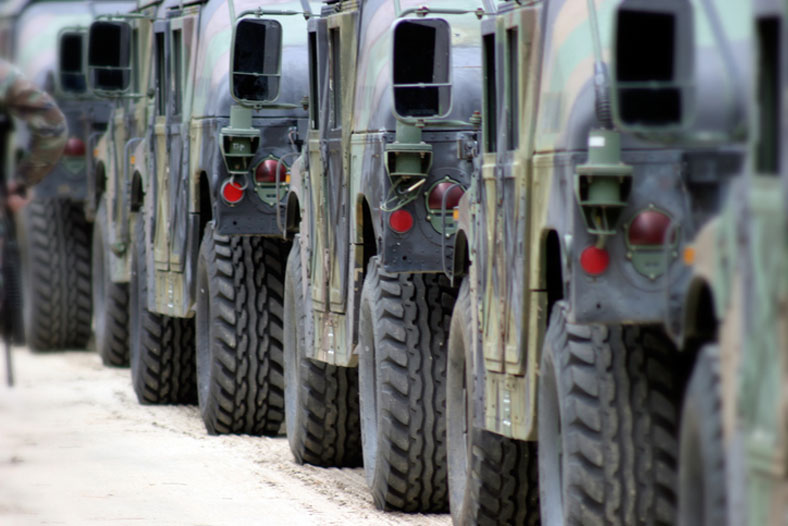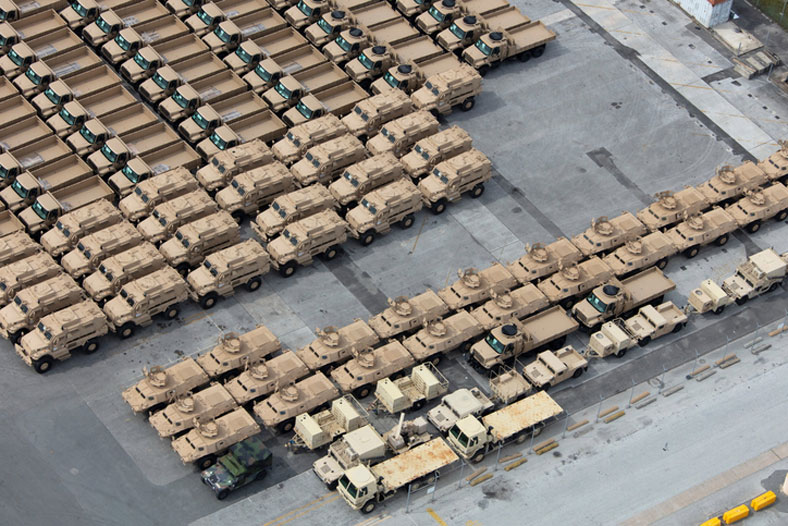Written by Scott Wilson

There are some supply chains where failure just isn’t an option. The logistics train that supports our ships, planes, tanks, and troops in the field is one of them.
Lives and national security are on the line. The sanctity of the country and the protection of every citizen is part of that package.
There’s no room for mistakes when it comes to managing the military supply chain.
On top of being critical, however, defense logistics is a field that is tremendously complex. The military-industrial complex represents a hybrid juggernaut of private corporations and entrenched government agencies wielding eye-watering budgets to achieve big objectives. That means it takes a whole other level of knowledge and specialization to manage the supply chain critical to making that possible.
The government defense procurement system is enormously tangled and highly regulated. Product specifications are intricate. In fact, there’s a specification for defining specifications, and it’s more than 100 pages long.
And all of it changes with every appropriations bill. And in a world where the threats evolve even faster than the regulations, you need a foundation that is flexible enough to help you keep up. You need a degree in supply chain management.
Managing the DoD Supply Chain Isn’t Just a Job for Military Logisticians

The military is where the concept and the very term logistics originated. As it became clear to strategists that winning the logistics battle meant winning the war, expertise in the field became prized.
While there are still many logistics professionals in uniform in the armed services, the high-tech, high-capacity modern military largely relies on private contractors to run the longest parts of its supply chain.
Yet those contractors can’t treat military supply lines quite the same as corporate supply chains. If a shipment of disc brakes goes missing somewhere south of Dubuque, an assembly line may have to slow up a bit, but it will get worked out. The same thing happens with a pallet of M107 155mm artillery shells, it’s a whole different world of trouble.
Military Supply Chain Managers Give Extra Attention to Mitigating Risk

Managers in defense supply chains deal with a whole host of considerations that other logistics professionals don’t routinely worry about. Tracking and inventory system hardening, submarine threats to transport vessels, satellite observation of transshipping hubs… it’s all in a day’s work for the DoD.
At the same time, they also handle all the routine risk management threats that any supply chain manager is familiar with:
- Counterfeit parts
- Sourcing diversity
- Weather hazards and equipment breakdown
- Record-keeping errors
- Material resource shortages
- Regulatory restrictions
DoD supply chain managers also must consider risks presented by adversarial sources for those threats. They need to be aware of espionage and sabotage efforts aimed at the military supply chain. And they must weigh the consequences for units running short on supplies.
Lessons in Military Supply Chain Management Come in Real-Time
 The 2022 Russian invasion of Ukraine has provided horrific real-time examples of modern DoD supply chain risks. With NATO nations a major supplier of Ukraine, defense supply chain managers here have had a first-hand look at the logistics difficulties of modern war.
The 2022 Russian invasion of Ukraine has provided horrific real-time examples of modern DoD supply chain risks. With NATO nations a major supplier of Ukraine, defense supply chain managers here have had a first-hand look at the logistics difficulties of modern war.
The United States alone sent more than $30 billion in weapons and supplies. But after an initial surge, shipments slowed. It turned out that the biggest choke point wasn’t in battle-beaten roads down the supply line — it was at the factories.
Once known as the Arsenal of Democracy, a combination of complexity and lower demand had reduced the amount of production plants capable of making modern arms and ammunition. The Scranton Army Ammunition Plant, where 155mm shells are made, maxes out at about 14,000 rounds per month. But Ukrainian batteries can fire off that amount in about two days.
There are no quick fixes. The Army plans to ramp up production to 90,000 rounds per month. But the facilities and staff to do so won’t be in place until 2025.
In the meantime, America’s own stockpiles are running low. Supply chain managers in and out of uniform are struggling to find solutions.
Jobs in Defense Supply Chain Management are Found in Both the Public and Private Sector

In every military branch, there are entire commands devoted to supply and logistics. But there is also a significant civilian presence in the military logistics chain, mostly centered around the Pentagon’s Defense Logistics Agency (DLA).
DLA employs more than 25,000 staff across the country and around the world. Those experts handle every phase of military supply chain support:
- Procurement
- Distribution
- Disposal
And they have experts in every aspect of military supply, from aviation to energy to electronics. So, experts in supply chain risk management are always in demand at the federal level.
DLA has also been tapped in recent years to support other federal agencies with supply procurement and distribution, including FEMA, the Forest Service, and the State Department.
On top of that, there are also many positions in military supply chain risk management that exist in the private sector.
Military suppliers are expected – both contractually and for reasons of self-interest – to be invested in managing supply chain risks. So, every major defense contractor hires supply chain professionals in relevant areas of specialization – from skilled logisticians to compliance specialists and materials examiners. Risk management is so integral to DoD logistics that the expectation for that skillset is baked into most job descriptions.
Of course, even if you’re not in the military, it helps to have been in the military at some point to land these positions. Both the training that comes with military supply corps jobs and the clearances you can earn are prized by contractors and the Department of Defense.
Government Salaries and Benefits Can Be Part of the Package in Military Supply Chain Management

The Bureau of Labor Statistics (BLS) tracks salary levels for various kinds of logistics professionals. Those categories include a vertical for Logisticians, who handle the heavy lifting in risk analysis and coordination, and Transportation, Storage, and Distribution Managers, who take on more senior leadership roles in SCM.
Unfortunately, they don’t track military salaries, and they don’t have an industry category specific to defense contracting.
What the BLS does keep track of, though, are federal government salaries. That covers many of the positions at DLA, DoD, CIA, and other three-letter agencies whose intelligence operations intersect with strategic military supply chains.
For 2022, the average federal salary level for logisticians was $93,750. On the management side, the median was $111,740.
In both cases, that puts them well above the overall averages for those roles across industries.
There’s a good bet that private sector defense supply chain risk managers at least match those salaries, and quite likely earn even more. On the other hand, government positions come with a lot of job security, excellent health benefits, and strong retirement packages.
The Right Degree for a Job in DoD Supply Chain Management

As with any niche in the supply chain world that requires intensive specialization, there are specific education options available for DoD supply chain managers.
In fact, there’s an entire university devoted to providing that training.
Defense Acquisition University was established in 1991 to help standardize training across the military in supply chain management. They offer coursework across seven functional areas in SCM:
- Auditing
- Business
- Contracting
- Engineering and Technical Management
- Life Cycle Logistics
- Program Management
- Test and Evaluation
Although DAU isn’t a degree-granting institution, courses offered there are commonly accepted for credit at other colleges.
Unfortunately for many students, not just anyone can attend classes at DAU. Eligibility is restricted to students serving in the military or working for the government. That can include working at non-DoD federal agencies or as an employee at a private defense contractor, however.
DAU isn’t the only service school with a decided focus on supply chain risk management. National Defense University, the Naval Postgraduate School, and the Air Force Institute of Technology all offer degree programs in aspects of SCM.
Of course, without eligibility to attend any of those programs, a civilian university degree in SCM works perfectly well. Those degrees are available at every level of schooling.
For those who already hold a degree in another major, both graduate and post-graduate certificate programs in supply chain management are a solid option that can save time and money. And for those looking to hone the kind of risk mitigation skills that reduce the likelihood of disruptions to critical military supply lines, certificates that drill right down into those concerns, include a Certificate in Managing Supply Chain Risk and Performance or a Certificate in Cybersecurity Supply Chain Risk Management.
There are even some specialized programs, like a Master of Science in Supply Chain Management with a concentration in Risk Management, that are aimed right at this critical role.
Professional Certification Can Validate You Have the SCM Skills the Military Relies On

The supply chain world has something in common with the military besides a heavy reliance on logistics: they both put a lot of weight on certifications.
Professional industry certification is different from a certificate you get from a college. Certification looks at your qualifications, training, and expertise.
Earning professional certification tells employers you know the SCM business, and that you have the specialized experience to prove it.
There are many and diverse types of civilian supply chain certifications available that are just as valuable in the DoD as in the outside world. Many of them do incorporate risk management as part of their emphasis, such as the CLTD (Certified in Logistics, Transportation and Distribution) from ASCM (the Association for Supply Chain Management).
Your career can get a boost from the right certifications, but education is always part of the qualifications. So, you’ll need to start off by getting a degree first. You owe it to yourself, and to the operations you’ll be supporting, to prepare for the worst by earning the best.
2022 US Bureau of Labor Statistics salary and employment figures for Federal, State, and Local Government, excluding state and local schools and hospitals and the U.S. Postal Service reflect national data, not school-specific information. Conditions in your area may vary. Data accessed September 2023.






